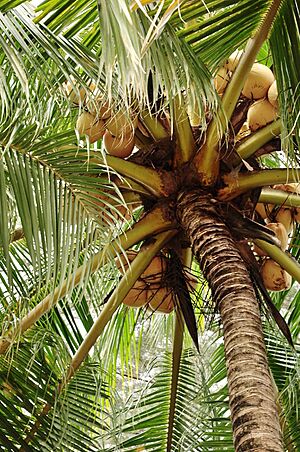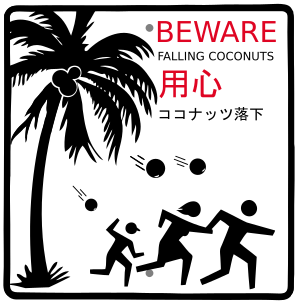Death by coconut facts for kids
Coconuts falling from their tall trees can sometimes hit people. This can cause serious injuries to the back, neck, shoulders, or head. Very rarely, these incidents can even be deadly.
After a study in 1984, some people started to spread exaggerated stories about how many deaths were caused by falling coconuts. An urban legend grew that falling coconuts kill many people each year. This story became very popular when an expert on shark attacks was thought to have said that 150 people die from falling coconuts worldwide every year. This number was often compared to shark attacks, which cause about five deaths per year.
Because of worries about falling coconuts, officials in Queensland, Australia, removed coconut trees from beaches in 2002. One newspaper even called coconuts "the killer fruit." However, real reports of deaths from coconuts go back to the 1770s.
Contents
Falling Coconuts: A Real Danger?
What are Coconuts?
Coconuts grow on the coconut palm tree (Cocos nucifera). These trees can grow up to 30 m (100 ft) (about 100 feet) tall. Their long leaves can be 4–6 m (13–20 ft) (13 to 20 feet) long.
A healthy coconut palm can produce up to 75 fruits each year, but usually it's fewer than 30. A full-sized coconut weighs about 1.44 kg (3 lb 3 oz) (about 3 pounds). Coconut palms are grown in over 80 countries, producing millions of tons of coconuts each year.
The Coconut Myth
The idea that many people die from falling coconuts started with a 1984 research paper. Dr. Peter Barss wrote about "Injuries Due to Falling Coconuts." He found that in Papua New Guinea, about 2.5% of hospital visits for injuries were from falling coconuts. None of these were deadly, but he mentioned two old stories of deaths.
This small number of two deaths was later misquoted as 150 worldwide. This happened because people wrongly assumed other places would have the same rate of coconut deaths. In 2001, Dr. Barss received an Ig Nobel Prize for his research. This award is given for research that "cannot or should not be replicated." Dr. Barss said that when you treat these injuries every day, it's not funny.
Where Did the Myth Come From?
After Dr. Barss's study, the exaggerated claims about coconut deaths spread. One writer, Joel Best, called the widespread death claims a "journalistic urban legend." The Shark Research Institute said a press release from a travel insurance company helped spread the myth. This company tried to sell travel insurance by saying coconuts were "ten times more dangerous than sharks."
In May 2002, the legend became even more popular. George H. Burgess, who studies shark attacks, claimed that "falling coconuts kill 150 people worldwide each year."
A study in 2001 looked at skull fractures from falling fruit over five years. It found that all these injuries happened to children under ten years old.
Real-Life Coconut Incidents
Deaths from Falling Coconuts

Here are some real examples of people who died from falling coconuts:
- Around 1777, a woman in the Cook Islands died after a green coconut hit her.
- In 1833, four people died from falling coconuts in Sri Lanka.
- In January 1943, a US Marine was killed in his sleep by a falling coconut in Guadalcanal.
- In 1952, a seven-month-old baby died in Malaysia when a coconut hit her head.
- In 1966, a person in Papua New Guinea was killed by a coconut while eating lunch.
- In July 1973, a two-year-old girl died in Diamond Head, Hawaii, when a cluster of 57 coconuts fell from a tree. This was Hawaii's first recorded death from falling coconuts.
- In November 1991, a person at a funeral in Sri Lanka was killed by a falling coconut.
- In April 2001, a person in Vanuatu died from a falling coconut during a storm.
- In August 2001, in Malaysia, a 59-year-old man was killed when a monkey, used to pick coconuts, dropped one on his head.
- In August 2002, a 6-month-old baby in Malaysia died when a coconut fell into her crib.
- In September 2003, a 65-year-old man in Malaysia was killed by a falling coconut during strong wind and rain.
- In March 2009, a 48-year-old man in Thailand was killed when a monkey, used to pick coconuts, kicked one down onto his head.
- In May 2010, a one-and-a-half-month-old girl in India died when a coconut hit her head during a religious ceremony.
- In August 2010, a 69-year-old man in Colombia was killed by a coconut that fell from a 12-meter (39 ft) (40-foot) palm tree.
- In 2013, a man in Colombo, Sri Lanka, died after a coconut fell on his head.
- In June 2021, an 11-month-old boy in India was killed by a falling coconut.
- In August 2021, a 20-year-old man in the Philippines died after four coconuts hit him during an earthquake.
Other Ways Coconuts Caused Harm
While most coconut injuries are from them falling, there have been other unusual incidents:
- In December 1923, in Pennsylvania, a man died trying to open a coconut with a loaded gun. The gun fired and shot him.
- In the 1930s, newspapers reported that a schoolboy in India died from a "magic" coconut. A teacher made students touch a coconut to find out who took a book. One student was forced to touch it, got a high fever, and died within an hour.
- In April 1983, a female whale died because a coconut husk got stuck in its intestine.
- In 1944, Japanese troops reportedly used "coconut bombs" against American soldiers. They put hand grenades and explosives inside hollowed-out coconuts.
- In July 2004, a man in Sri Lanka was killed by a coconut during a fight. Police said it didn't fall from a tree.
Sometimes, whole coconut palm trees can fall and cause harm:
- In April 1992, an 81-year-old man in Malaysia was killed when a coconut tree, uprooted by strong winds, fell on him.
- In May 2006, a man and a boy in the Philippines were killed by falling coconut palm trees during a tropical storm.
- In August 2011, a 56-year-old man in Malaysia was killed when a whole coconut tree fell on him while he was riding his motorcycle.
- In August 2020, a 37-year-old man in Thailand died from head injuries when a coconut tree he was helping to cut down fell on him.
However, coconut palm trees have also saved lives. People have tied themselves to these strong trees for safety during high winds or tsunamis.
Coconuts and the Law
Injuries and deaths from falling coconuts have led to some legal cases:
- In 1956, the City of Miami paid $300 to a woman after a coconut fell from a city tree and hit her foot. The city lawyer said the city should have known the coconut was about to fall when it turned brown.
- In 1977, a jury in Hawaii awarded $39,000 to a police officer. He was hit in the head by a falling coconut while cleaning a public sidewalk. The property owner was sued for not taking care of the trees.
Coconuts in Pop Culture
Coconuts and their dangers have appeared in many stories and shows:
- The American poet Frederick Seidel wrote a poem called "Coconut." It included lines about a coconut falling and hitting someone on the head, possibly killing them.
- On their 1995 CD, Bob Gibson and Shel Silverstein had a song called "Killed by a Coconut." It humorously describes people dying from coconuts.
- Falling coconut injuries were shown in the TV series Gilligan's Island. In one episode, Gilligan gets hit in the nose by a coconut. The show's creator, Sherwood Schwartz, said that actor Bob Denver was very good at slapstick comedy, like reacting to a falling coconut.
- In the 2000 movie Cast Away, the character played by Tom Hanks hears loud thuds. He later realizes they are coconuts falling.
- The video game Donkey Kong 3 features Donkey Kong throwing coconuts at the player.
- In the SpongeBob SquarePants episode "Rock-a-Bye Bivalve," Patrick Star loves a TV show where a man just gets hit in the head by a coconut.
- In the Sonic the Hedgehog video game series, some robot enemies shaped like monkeys throw coconuts from trees at Sonic.
Images for kids
See also
 In Spanish: Muerte provocada por caída de coco para niños
In Spanish: Muerte provocada por caída de coco para niños






